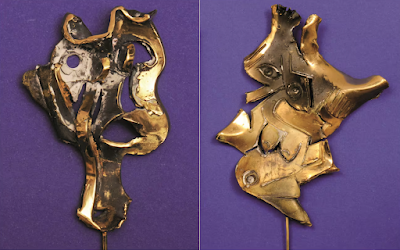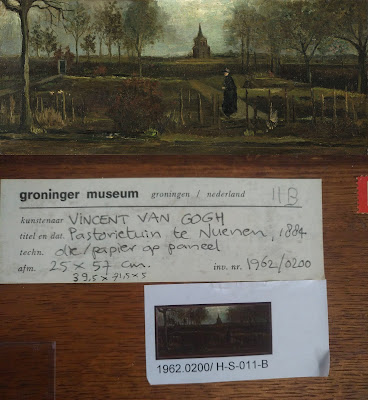Forty-nine year old, repeat art napper, Henk Bieslijn has been sentenced to four years in prison in the Netherlands for the broad daylight failed theft of Oscar-Claude Monet's De Voorzaan en de Westerhem from the Zaans Museum in Zaandam.Here is a timeline of how the events in that case developed.
16 August 2021 - An attempted theft, occurs at around half-past ten at the Zaans Museum in Zaandam, Netherlands
During the incident, one culprit, later determined to be Henk Bieslijn walked into the Zaans Museum during opening hours wearing a wig as a disguise. After nonchalantly grabbing Claude Monet's De Voorzaan en de Westerhem, the law-breaking art aficionado exited the museum, only to be spotted by a bystander, who attempted to impede the thief's progress by grabbing hold of him.
In the ensuing confusion, three shots were fired and the pilfering art thief dropped the Monet but successfully mounted the back of a black motorbike driven by the accomplice.
Thankfully, no one is injured, and the artwork by the famous French impressionist was quickly returned to the museum. Albeit, slightly worse for the wear. A short while later, law enforcement authorities recovered the get-away vehicle after it had been abandoned by Bieslijn and his accomplice on the Zuiderweg in nearby Wijdewormer.
21 August 2021 - A former art burgler walked into a police station
Dutch newspapers announce that a man named "Henk B." reported to be one of two thieves involved in the Zaans Museum failed heist, had walked himself into the Noord-Holland police to answer questions regarding the attempted theft of the Claude Monet painting.
It is almost immediately clear that this individual is Henk Bieslijn, who on 7 December 2002, was involved in the nighttime burglary of the Van Gogh Museum in Amsterdam. In that incident, two works of art, Congregation Leaving the Reformed Church in Nuenen and View of the Sea at Scheveningen by Vincent Van Gogh we stolen, and remained missing, in the hands of organised crime actors, until 2016.
January 2022
A second suspect in the Zaans Museum attempted theft, this one, a thirty-seven year old unnamed man from Purmerend, is taken into custody. He is subsequently released after questioning.
19 April 2022 - Bieslijn confesses
Appearing before the Dutch court in Alkmaar, Henk Bieslijn admits to the court that he attempted to steal Claude Monet's De Voorzaan en de Westerhem from the Zaans Museum, purportedly under pressure from criminals. Bieslijn, claimed that after serving his time for the 2002 Van Gogh Museum burglary, he had left behind his former life of crime and until recently had been working at festivals until the COVID pandemic resulted in him being underemployed.
To fill the gaps, Bieslijn stated that he had decided to begin selling marijuana, and claimed he had picked up a substantial quantity of cannabis for resale, passing it off to another individual in the front of a cafe, while he, in turn, walked out the back. Bueslijn then claimed that this person disappeared, which resulted in him being left with a debt of some €12,000 euros to the organisation he bought drugs from.
Bieslijn also told the court that after the 2002 Van Gogh theft, he had been approached by criminals on more than one occasion, each time, as they purportedly looked for someone to conduct a similar heist. During each of these prior incidents, the purportedly reluctant art thief claimed he turned the criminals down. That is until 2021, when he was persuaded otherwise, with what he perceived to be threats towards his son.
Bieslijn told the Dutch Court that on Saturday evening, 14 August 202, his telephone rang and he was ordered, not asked, to steal the Monet at the Zaans Museum in Zaandam, with the assistance of an accomplice. The art thief stated he never thought the daylight theft would be successful, but had agreed to participate in hopes of showing that he was willing to cooperate, and in doing so, ensure the protection of his son.
Bieslijn denied having fired a weapon on the day of the attempted robbery but admitted that the pair had first escaped on the getaway scooter later found abandoned on the Zuiderweg. The accomplices then took a car in the direction of Purmerend, where at some point on their journey, Bieslijn got out of the car at a bus stop and took a bus back to the city of Amsterdam.
Not believing Bieslijn's testimony as stated, and given his prior involvement in the Van Gogh Museum thefts, the Prosecutor asked that he be sentenced to four years in prison. IN making this recommendation, the prosecutor noted that at no point had the former art thief come forward to report any of the purported earlier incidences of coercion or intimidation and had also failed to go to the authorities on the day if the Zaans Museum theft, even after shots had been fired.
3 May 2022 - The court hands down its sentence.
Citing the "particularly brutal theft in broad daylight" the Judge in Henk Bieslijn's case granted the public prosecutor's request and sentenced the two-time art thief to four years in jail. In issuing their ruling the court concluded that the theft of the Monet painting was completed, not merely attempted, as at the time of the incident, the artwork had been taken from its mount inside the museum and carried outside. The judge further stated that the court wouldn't take Bieslijn's purported criminal debt, or possible criminal coercion into consideration, as the incident involving the lost bag of weed could not be verified, nor did it diminish the seriousness of the crime.
The sentence of four years is similar to the one Bieslijn received on 26 July 2004, along with his coconspirator Octave Durham, for their roles in the museum burglary which nabbed Vincent Van Gogh's Congregation Leaving the Reformed Church in Nuenen and View of the Sea at Scheveningen. One hopes that this time it may serve as a deterrent.
 Edgar Degas,Édouard Manet,Govert Flinck,Isabella Stewart Gardner Museum,Johannes Vermeer,museum theft,Rembrandt van Rijn
Edgar Degas,Édouard Manet,Govert Flinck,Isabella Stewart Gardner Museum,Johannes Vermeer,museum theft,Rembrandt van Rijn
 No comments
No comments

















































